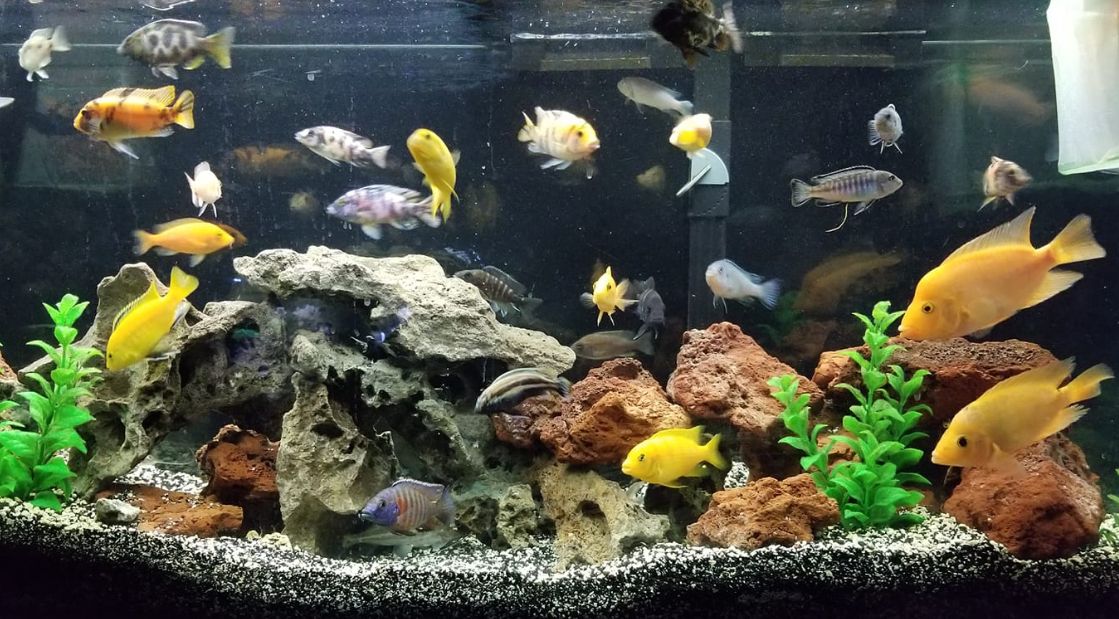
A Caveat: Protein Level in the Food
The most important variable when choosing a fish food is the protein level. The higher the protein level in any food the healthier the fish. But this effect is NOT because eating high protein food is good for a fish. Rather the effect is due to what high protein food can do to the ecosystem that is in any aquarium. Higher protein food is a significant factor in creating crystal clear water. In turn, crystal clear water gives very healthy fish.
Note I personally simply buy the highest protein level I can find if I need to buy commercial pelleted fish food.
But it should also be noted that the BEST food is both homemade gel and Mazuri gel foods. Both of these are roughly 55% protein with very low carbohydrates. More information can be found in this article:
3.4. Homemade Gel Foods
Running a close second to these gel foods are just human food sliced or grated down to a size suitable for a fish to eat. Tilapia filets, canned shrimp, chopped beef heart, etc. are all excellent food for fish and better than anything one can buy off the shelf.
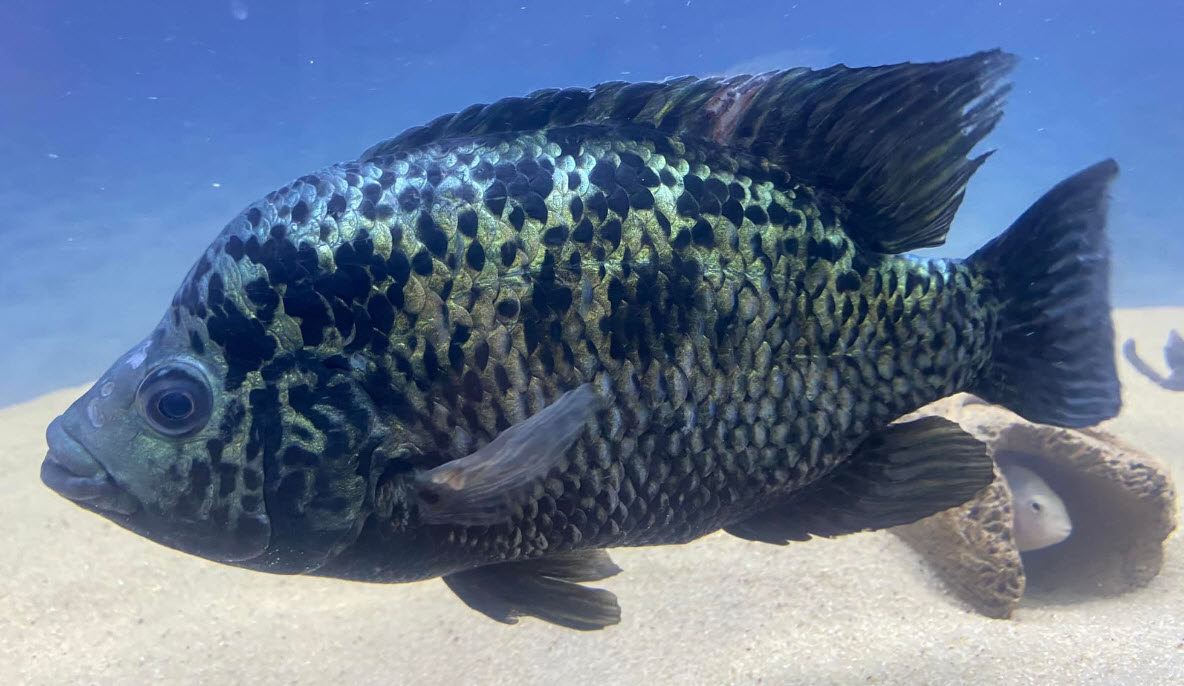
Cause and Effect
Low protein food does not directly produce unhealthy fish. Rather its effect is indirect, through a long line of causal effects:
- A low protein food typically has a high carbohydrate content
- Carbohydrates are only 50% digested by the fish
- The undigested carbohydrates create dissolved organic compounds (DOCs) that have a high carbon to nitrogen ratio
- Pathogenic bacteria and other pathogenic organisms proliferate with high carbon to nitrogen ratio DOCs
- The proliferation of these organisms in the water column results in “dull” or even slightly milky water
- These pathogenic bacteria and other organisms in the water column attack the fish
Now everyone wants to know what defines a low protein food. I make the cut-off at 45% for dry commercial fish food. But the “45% protein” level is completely arbitrary. In truth there is a continuum between 30% and 60%. A level of 42% protein in the dry commercial fish food won’t be “ideal” but it also won’t be that bad. The key is the clarity of the water. Is the 42% protein food giving crystal clear water? Or is it giving “dull” water or even slightly cloudy water. There is a “threshold” here.
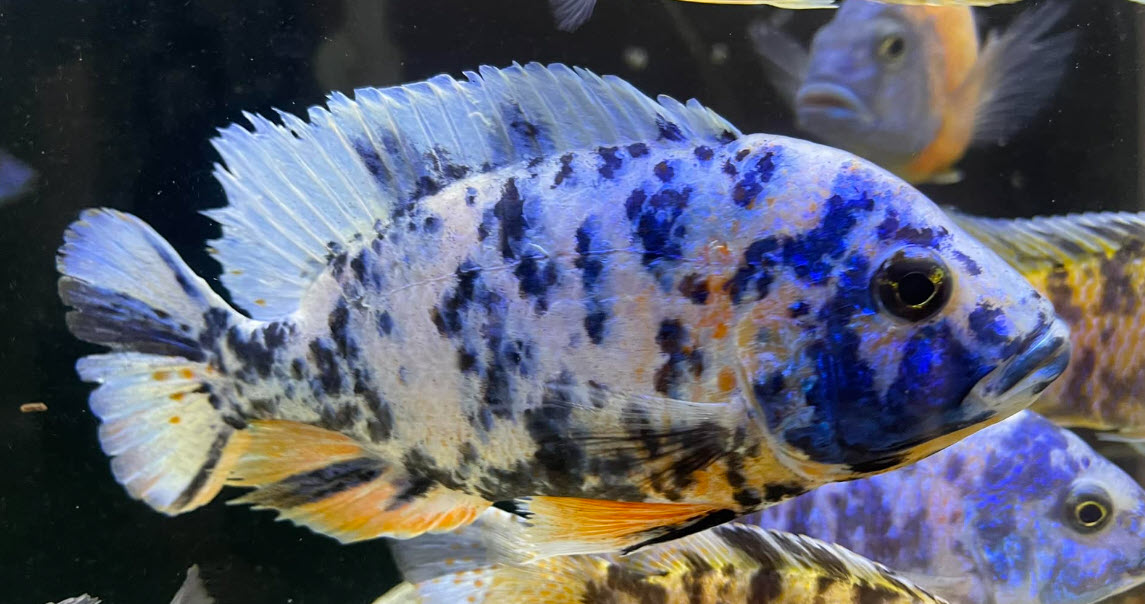
But where the threshold will be is very dependent on a multitude of variables. For instance, 34% might give crystal clear water in one aquarium setup while 52% might give “dull” water in another aquarium setup. Note that if I must buy commercial fish food, I ALWAYS buy the highest protein level I can find.
Ideally this “optimum” of 45% protein would be phrased as a carbohydrate level of less than 30%. But fish food does not have the level of carbohydrate on the label so one has to do some math to calculate it. Most fish food with levels of protein above 45% have less than 30% carbohydrates. But I have found exceptions.
Below I will discuss those food variables that directly affect the fish. This is with the clear understanding that all these effects are minor compared to the effect of the protein level on the health of the fish via the creation of a pathogen filled water column.
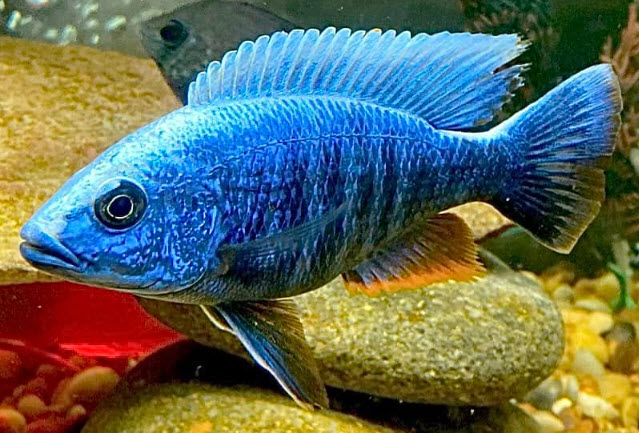
Fish Food in General
A major concern for most fish keepers is what is the best food for their fish. Most “normal” commercial pelleted food made for fish today is excellent, so it is difficult to go wrong when feeding fish, contrary to popular mythology. There are two exceptions to this. Most of the commercial “veggie” foods analyzed and some of the flake foods analyzed had too low of a protein level to be considered “good” foods by the author. But note this is an “OPINION“, unsupported by the research.
What is far more important than the type of food is the amount of food. The biggest mistake beginners do is to over-feed their fish. The directions on the food are ridiculous. “two to three times a day an amount they can eat in two minutes” is WAY too much food. Fish are cold-blooded creatures and only need small amounts of food once a day.
What I recommend for feeding is simple;
.
Feed fish once a day ONLY an amount of food the fish can consume in one minute.
.
If there is food still in the aquarium after one minute you need to cut back on the amount.

Now every fish owner wants his fish to be in the best health possible. But research has shown little or no effect on life expectancy or the health of the fish with various fish diets. There are four slightly desirable characteristics only:
- For optimum juvenile growth rate, have over 40% protein
- For optimum fertility, have over 10% fat
- For optimum juvenile growth rate, have less than 30% cheap protein from the likes of soybeans
- For optimum growth rate in juveniles have “whole fish” or “fish meal” as one or more of the first few ingredients in fish food.
The protein level is more important than the fat level. But it must be emphasized that this is all relative. Fish do just fine with food that is outside this range. All of the research found differences in the growth rate of juvenile fish and the fecundity of fish with foods at less than these levels. But the survival rates of the fish didn’t change with levels less than these “optimums”.
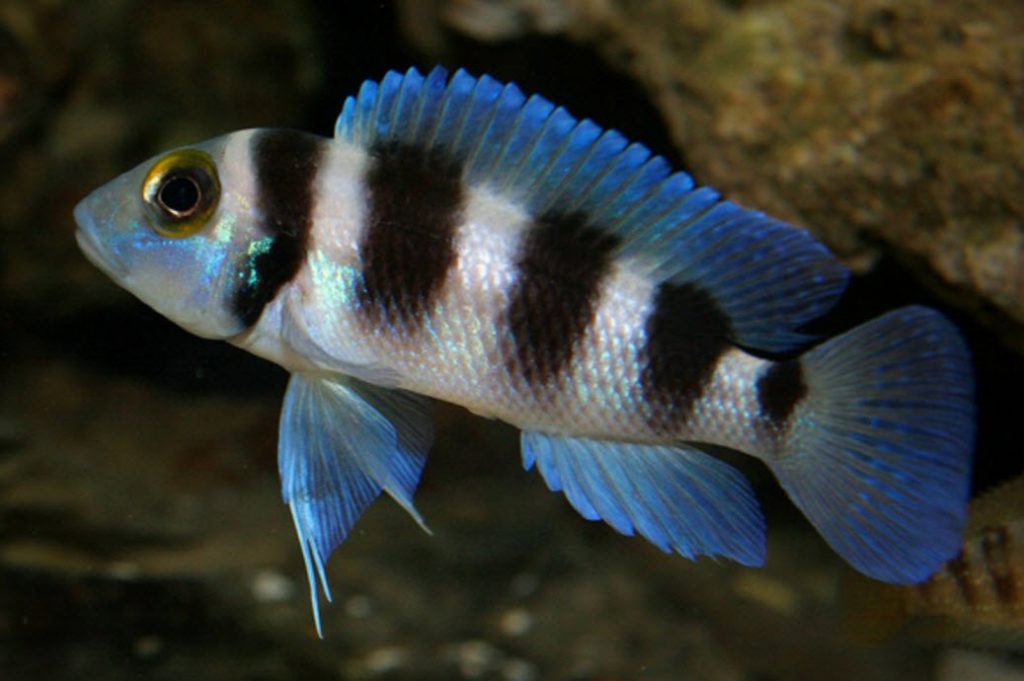
Here are some popular fish foods, rated by protein level. Obviously the Aquamax 500 is the best food.

This chart is based on the protein level of the food
- Green best >50% protein
- Yellow excellent 45-49% protein
- Orange good 40-44% protein
- Pink poor 35-39% Protein
- Blue bad 30-35% protein
- Purple bad >50% filler
There are many more tables in this article:
3.6.1. Commercial Dry Fish Food
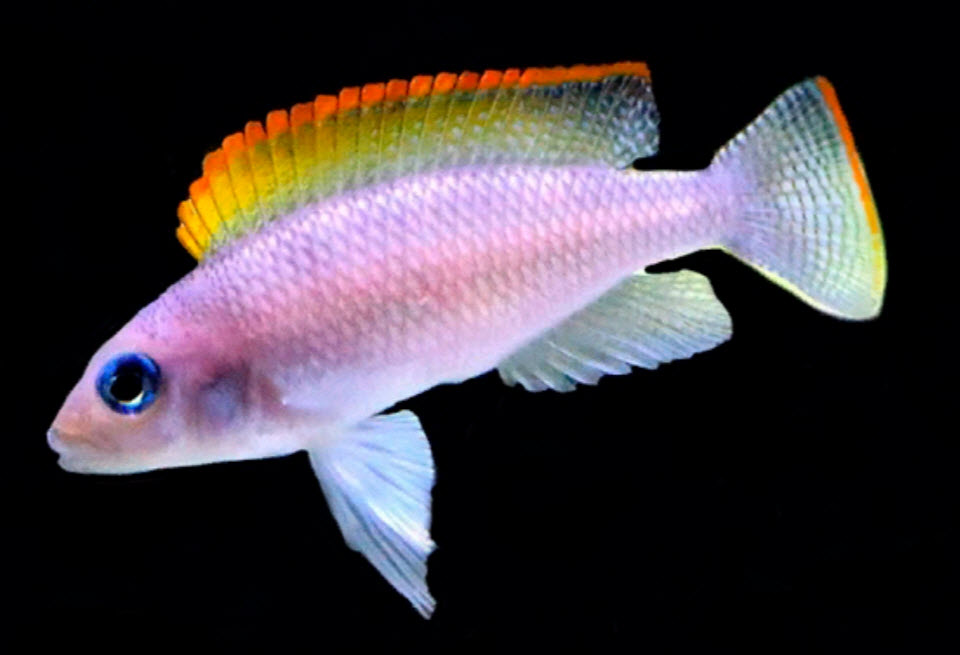
Fish Food Myths
There are a huge number of myths parroted around social media about fish foods. Some of these myths are:
- Different types of fish (herbivores, carnivores) can’t be kept together because they require different foods.
- Feed fish only what they can consume in five minutes.
- Mbuna get “Malawi bloat” when fed high protein food.
- “Just like us, fish enjoy a varied diet”.
- Live foods are the best foods for tropical fish.
- Animal protein has an inferior nutritional content compared to plant protein.
- There is such a thing as “high quality” and “low quality” protein.
- Chicken, tilapia, and beef are bad foods for fish.
- Fat is bad in fish food
- Krill, bloodworms, and tubifex worms are bad for fish.
- Mbuna are herbivores and eat only plants.
- Some fish require live foods.
- Wheat, corn, rice, oats, and potatoes are good foods for herbivore fish.
- Fish will starve before eating a fish food they don’t “like”.
- Fish like some garlic in their food
.
These myths are ALL false!
.

Food I Avoid
For various reasons I avoid some types of food:
- Live brine shrimp – You are paying a lot of money for something that is 90% water. If you raise them yourself it is a lot of cost and trouble for no clear benefit. No research says there is any benefit to live brine shrimp.
- Live feeder fish – These will have diseases like ich which they will transfer to your good fish
- Frozen foods – Again, you are paying a lot of money for something which is 90% water. And I have found a lot of frozen food which has defrosted spoiled and been refrozen. This will give fish food poisoning. No research says there is any benefit to frozen food.
- Flake Food – My fish create clouds of debris with flake food and the cost per pound is very high. I only use this for fry.
- Freeze dried food – Cost is just WAY too high. It is $184 per pound for Hikari Freeze Dried Tubifex

Fish Food Information Main Menu
This is the index for a compendium of information on the topic of fish food.
3.1. Insignificance of Food
3.2. Fish Diet Specializations
3.3. Amount of Food to Feed
3.4. Gel Fish Food
3.5. Breaking Up Food
3.6. Commercial Dry Fish Food
3.7. Banned Fish Food
3.8. Food and Bloat
3.9. Fish Food and Brown Gunk Formation
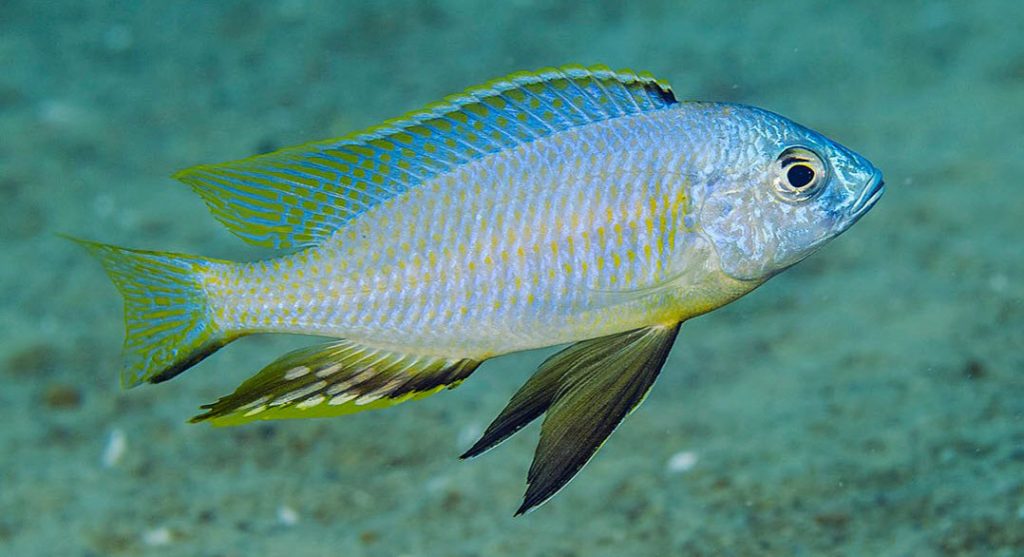
Return to Home Page and Main Menu
.
Aquarium Science Website
The chapters shown below or on the right side in maroon lead to close to 400 articles on all aspects of keeping a freshwater aquarium. These articles have NO links to profit-making sites and are thus unbiased in their recommendations, unlike all the for-profit sites you will find with Google. Bookmark and browse!
.

Dave says
Go ahead and email me at dlboge2@gmail.com
John Henry says
“In reply to John Henry ……… I don’t think its the food. Sounds more like a filtration issue. When I feed gel food it clouds the water a little bit but the filtration I have is huge so it rapidly clears.”
Is it possible to chat to you via email so I can send photos of my sump set up or do you prefer I describe my filtration in this chat? I seem to be having issues with my static submerged sump & not quite sure what is wrong.
Dave says
In reply to John Henry ……… I don’t think its the food. Sounds more like a filtration issue. When I feed gel food it clouds the water a little bit but the filtration I have is huge so it rapidly clears.
John Henry says
Hello Dave,
I attempted your Gel Food recipe & used tinned salmon, dried spirulina & added some fish meal as per the recipe.
I wasn’t sure how much fish meal to add as it didn’t state the quantity & so I put an amount equal to the spirulina (about 50 grams).
After feeding a tiny amount, the tank went extremely cloudy & still hasn’t cleared after a couple of days.
I’m pretty sure I’ve overdosed on the fish meal. so can you kindly tell me the correct quantity?
I used 425grams of tinned salmon & 50 grams of spirulina, all mixed in with the plain gelatine.
Dave says
In reply to Andreas …… Food makes little or no difference to the ability of fish to spawn or raising the spawn. Just fed them the highest protein food one can find. Shredded frozen tilapia is excellent as is shredded shrimp. The various gel foods are also excellent. Food is just not the big deal everyone makes it out to be.
Andreas H. says
Hi Dave,
I was wondering whether the home made gel food recipes you suggest would be a good way to condition fish for spawning and to raise any subsequent fry?
Various online sources suggest live food, in particular live baby brine shrimp, as the best or only way to do so but as a father of three with a full time job, I definitely don’t have time for such things. I do however have the time to grind up offal, vegetable matter and various other ingredients and to freeze them in large batches once in a while.
Thanks for the very informative website.
Andreas
Anonymous says
This one looks good and quite cheap for commercial food:
https://www.sera.de/en/product/pond/sera-sterlet-pellets/
Crude Protein 50.0%, Crude Fat 15.0%, Crude Fiber 2.5%, Moisture 5.0%, Crude Ash 8.0%.
It says it is for sturgeons but I guess Goldfish and Ancistrus should like it?
Dave says
In reply to anonymous ….. dried mealworms are an excellent food but kind of expensive. Can you find a pelleted food with over 45% protein? Or just shred frozen tilapia filets.
Anonymous says
I see you talk about earthworms also being a good food, but all I find are dried mealworms, are these also good? I have been feeding Tetra Flakes to my fish, and it’s true it clouds the water after a while, even with decent filtration such as undergravel filter + hang on back filter in what should not be heavy stocking aquarium I think (4 comet goldfish + 2 clown loaches + 1 Ancistrus Gold) on a 65 Gallon tank.
Composition it says 51% protein + 29% fat + 2% fiber + 10% ashes, so being a really low amount of carbohydrates it should be good, right?
Dave says
In reply to Han ….. Commercial foods based on insect larvae are generally quite good food and can be used as the staple food. But note that the bug bites formula is only 20% insect larvae and only 40% protein. I personally like food with greater than 45% protein levels.
Han says
what do you think about insect based diet?. i feed my fish ground black soldier larvae, and they seem to like it. should it be staple food ?. i mainly fed my fishes commercial food(hikari pellets) and BSF. thanks
Alex says
Do you have any information on offering ostracods, copepods and the like to aquarium fish?
Dave says
In reply to Dan B. ….. Ron’s fish food doesn’t have the analyses required for making a judgement. So, much as I like Ron, I can’t make a recommendation.
Dan B says
What do you think of Ron’s cichlid food? Either mbuna or adult blends. I see you recommend his medicated combo that’s offered. Thanks for all the great info on your site.
Dmitri says
In Eastern Europe it is common to feed fish with dried (not freeze dried, but, for example, sun dried) aquatic crustaceans, such as daphnia and scuds. It is sold at a price significantly cheaper than commercial fish food. Dried daphnia contains over 43% protein and 9% fat. Scuds can contain up to 50% protein. However, it is criticised by commercial food vendors for having less vitamins and no extra ingredients compared to commercial food, allegedly eventually leading to fish deseases. On the other hand, the selfish motive for their criticism is evident. What is your opinion on this?
Dave says
In reply to KARTHICK ….. Only with SUPERB filtration. Good won’t cut it.
KARTHICK says
Can I Over feed(2% to 4% of body Weight) my Gold Fish if i have a Good filtration?
Dave says
Sai … Over sized food does no harm to the fish.
Sai says
Feeding bait larger than the fish’s mouth uses more energy to eat and weakens the fish. The bait can get stuck and die.
I saw a YouTube video claiming this. Are these true?
Dave says
In reply to Bhuwan…. The correct methodology is the 1% by weight per day figure. The other two methods (one minute of food or two eyeballs of food) are only gross approximations which vary considerably by the type of food being fed and the fish being fed. But the 1% method takes some math and doesn’t work too well with beginners. Thus the confusion.
Bhuwan Chander says
At one place you said that give fish food which they finish in one minute and other place you said give 1% of body weight fish food. There is three times difference in one minute food and food by weight? Kindly clarify l.
Dave says
In reply to Joshua ….Dr. Bassleer’s food is actually pretty good food if you ignore all the “probiotic” snake oil claims
Joshua Austin says
Have you checked out Dr. Bassleer pellet food? If I am understanding your method of analysis and the label on their food is correct, then I think it should be in competition with the gel foods you mentioned. The smaller pellet sizes are 54% protein, with the larger being only 47%. The ingredients look good too. I’d be interested in your thoughts if you get the time to have a look.
Dave says
In reply to Alexis …. There is no science that I could find to back up that claim
Alexis says
Hello! Are you familiar with the idea that feeding a fish a pea helps with constipation and causes them to produce a bowel movement? I’ve heard this many times online but am not sure if it’s backed up by any science. I believe my betta fish may be constipated (no bowel movement seen in over a week). Thank you and I love your website!
Dave says
In reply to Jimmy …. I wouldn’t feed a commercial dry food. Rather I would feed homemade gel food, Mazuri carnivore gel food, chunks of tilapia filet, earthworms, deshelled shrimp, etc. All the large food pellets have like 36% protein, which is just too low for my tastes.
Jimmy says
What commercial food would you recommend for larger bottom feeders like bichirs? Aquamax 300 is great for small/medium sized fish but too small for bichirs. Thank you.
Dave says
In reply to Jimmy … You are correct. All types of fish will thrive on it.
Jimmy says
Hi Dave, can one feed Aquamax 300 to all kinds of aquarium fish? Thank you.